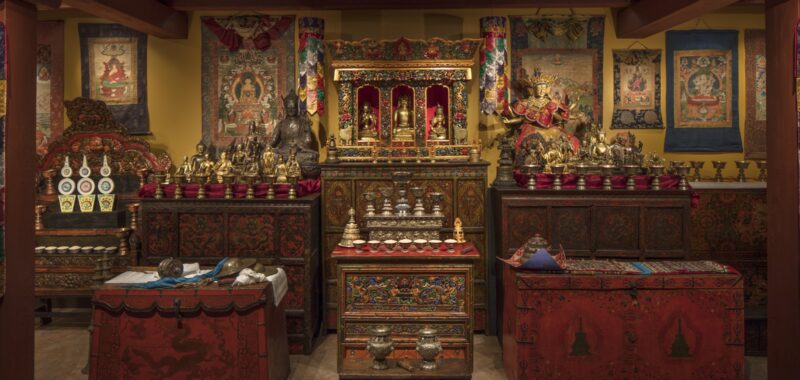Ahead of the closure of New York City’s Rubin Museum of Art, slated to shutter its Manhattan location this Sunday, October 6, a local group of activists is calling on the institution to repatriate Tibetan and Himalayan objects in its collection.
Since March, the Tibetan-led campaign Our Ancestors Say No (OASN) has been protesting the museum and collecting online petition signatures demanding the return of what they allege are stolen sacred cultural artifacts. These include the objects that make up the Rubin’s popular Tibetan Buddhist Shrine Room, which features scroll paintings, religious ritual objects, musical instruments, furniture, and ornamental textiles. The installation is slated to relocate to the Brooklyn Museum, where it is will reopen in June in a custom space in the Arts of Asia galleries, marking the beginning of a six-year collaboration between the two institutions.
“As a group of Tibetans organizing to hold the Rubin Museum accountable for decades of violent exploitation of our sacred ancestral objects, we strongly oppose the museum further displacing the Tibetan Shrine Room to the Brooklyn Museum for the next six years,” reads a statement on the OASN website.

The decision to relocate the installation is part of the Rubin’s shift to what it describes as a decentralized “global museum” model, in which the institution will exhibit its collection through partnerships with cultural organizations around the world. The move comes after years of reported financial issues — although the museum maintains that it is in a “strong financial position” — that compound growing criticisms over the provenance of its collection.
Dedicated to the preservation, research, and enjoyment of Himalayan art, the Rubin was founded in 2004 by New York philanthropist couple Shelly and Donald Rubin, who began amassing their collection of Himalayan objects in the mid-’70s — a time period notorious for widespread looting cultural heritage in the region.

According to its 2023 annual report, the Rubin’s collection holds “nearly 4,000 objects spanning 1,500 years from the Himalayan areas of India, Nepal, Bhutan, the Tibetan Plateau, and related Mongolian and Chinese cultural regions.” In 2022, the museum returned two Nepali objects after they were identified as stolen.
“The Rubin vehemently opposes the trafficking of stolen or looted cultural items and has never knowingly acquired any such objects,” a museum spokesperson told Hyperallergic.
Emphasizing a commitment to ongoing research into the provenance of its collection, the spokesperson said in the event that the museum discovers any illicitly acquired objects in its collection, it “will address all claims responsibly, which could include the return of the objects to countries of origin.”
The Brooklyn Museum has not yet responded to Hyperallergic’s request for comment.

Last Friday, OASN protesters rallied outside the Rubin during a museum gala event commemorating its upcoming transformation and its inaugural no-strings-attached $30,000 Rubin Museum Himalayan Art Prize. Outside the institution’s entrance, demonstrators held “Robbin Museum” signs featuring images of antiquities in the Rubin’s collection and erected an altar with candles and flowers. They plan to hold another action this Friday, October 4.
“Museums, which profit off the continued dispossession of our object relatives, are inherently at odds with true ethical stewardship. This is true of the Rubin, and it’s especially true of the Brooklyn Museum,” the OASN activist said.


